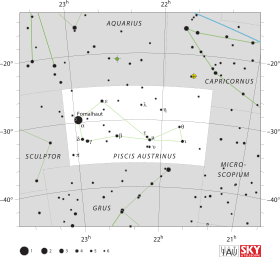Gamma Piscis Austrini
Gamma Piscis Austrini (γ Piscis Austrini) is binary star[3] system in the southern constellation of Piscis Austrinus. It is visible to the naked eye with a combined apparent visual magnitude of +4.448.[2] As of 2010, the pair had an angular separation of 4 arc seconds along a position angle of 255°.[9] Based upon an annual parallax shift of 15.14 mas as seen from the Earth,[1] the system is located about 215 light years from the Sun.
 | |
| Observation data Epoch J2000.0 Equinox J2000.0 (ICRS) | |
|---|---|
| Constellation | Piscis Austrinus |
| Right ascension | 22h 52m 31.53513s[1] |
| Declination | −32° 52′ 31.8059″[1] |
| Apparent magnitude (V) | +4.448[2] (4.59 + 8.20)[3] |
| Characteristics | |
| γ PsA A | |
| Spectral type | A0 Vp(SrCrEu)[4] |
| U−B color index | −0.038[2] |
| B−V color index | −0.046[2] |
| γ PsA B | |
| Spectral type | F5 V[5] |
| U−B color index | −0.08[5] |
| B−V color index | +0.44[5] |
| Astrometry | |
| Radial velocity (Rv) | 16.5±2.7[6] km/s |
| Proper motion (μ) | RA: −32.73[1] mas/yr Dec.: −21.21[1] mas/yr |
| Parallax (π) | 15.14 ± 0.57[1] mas |
| Distance | 215 ± 8 ly (66 ± 2 pc) |
| Absolute magnitude (MV) | −0.20/3.50[5] |
| Details[7] | |
| γ PsA A | |
| Mass | 2.63 M☉ |
| Surface gravity (log g) | 3.92 cgs |
| Temperature | 10,776±366 K |
| Rotational velocity (v sin i) | 47 km/s |
| Age | 214 Myr |
| Other designations | |
| Database references | |
| SIMBAD | γ PsA |
| γ PsA A | |
| γ PsA B | |
The magnitude 4.59[3] primary, component A, is a white-hued, chemically peculiar A-type main sequence star with a stellar classification of A0 Vp(SrCrEu).[4] It is an estimated 214 million years old with 2.63 times the mass of the Sun. The fainter magnitude 8.20[3] companion, component B, is an F-type main sequence star with a class of F5 V.[5]
Gamma Piscis Austrini is moving through the Galaxy at a speed of 24.1 km/s relative to the Sun. Its projected Galactic orbit carries it between 21,600 and 30,800 light years from the center of the Galaxy. It came closest to the Sun 1.8 million years ago when it had brightened to magnitude 3.78 from a distance of 157 light years.[10]
Naming
In Chinese, 敗臼 (Bài Jiù), meaning Decayed Mortar, refers to an asterism consisting of refers to an asterism consisting of γ Piscis Austrini, γ Gruis, λ Gruis and 19 Piscis Austrini. Consequently, the Chinese name for γ Piscis Austrini itself is 敗臼三 (Bài Jiù sān, English: the Third Star of Decayed Mortar.)[11]
References
- van Leeuwen, F. (2007), "Validation of the new Hipparcos reduction", Astronomy and Astrophysics, 474 (2): 653–664, arXiv:0708.1752, Bibcode:2007A&A...474..653V, doi:10.1051/0004-6361:20078357.
- Rakos, K. D.; et al. (February 1982), "Photometric and astrometric observations of close visual binaries", Astronomy and Astrophysics Supplement Series, 47: 221–235, Bibcode:1982A&AS...47..221R.
- Eggleton, P. P.; Tokovinin, A. A. (September 2008), "A catalogue of multiplicity among bright stellar systems", Monthly Notices of the Royal Astronomical Society, 389 (2): 869–879, arXiv:0806.2878, Bibcode:2008MNRAS.389..869E, doi:10.1111/j.1365-2966.2008.13596.x.
- Abt, Helmut A.; Morrell, Nidia I. (July 1995), "The Relation between Rotational Velocities and Spectral Peculiarities among A-Type Stars", Astrophysical Journal Supplement, 99: 135, Bibcode:1995ApJS...99..135A, doi:10.1086/192182.
- Corbally, C. J. (1984), "Close visual binaries. I - MK classifications", Astrophysical Journal Supplement Series, 55: 657, Bibcode:1984ApJS...55..657C, doi:10.1086/190973.
- Gontcharov, G. A. (2006), "Pulkovo Compilation of Radial Velocities for 35 495 Hipparcos stars in a common system", Astronomy Letters, 32 (11): 759, arXiv:1606.08053, Bibcode:2006AstL...32..759G, doi:10.1134/S1063773706110065.
- David, Trevor J.; Hillenbrand, Lynne A. (2015), "The Ages of Early-Type Stars: Strömgren Photometric Methods Calibrated, Validated, Tested, and Applied to Hosts and Prospective Hosts of Directly Imaged Exoplanets", The Astrophysical Journal, 804 (2): 146, arXiv:1501.03154, Bibcode:2015ApJ...804..146D, doi:10.1088/0004-637X/804/2/146.
- "gam PsA -- Double or multiple star", SIMBAD Astronomical Database, Centre de Données astronomiques de Strasbourg, retrieved 2017-05-18.
- Mason, B. D.; et al. (2014), The Washington Visual Double Star Catalog, Bibcode:2001AJ....122.3466M, doi:10.1086/323920.
- Gamma Piscis Austrini (HIP 112948) Archived 2015-09-23 at the Wayback Machine
- (in Chinese) AEEA (Activities of Exhibition and Education in Astronomy) 天文教育資訊網 2006 年 7 月 5 日
External links
- Kaler, James B. (October 29, 2010), "Gamma Piscis Austrini", Stars, University of Illinois.